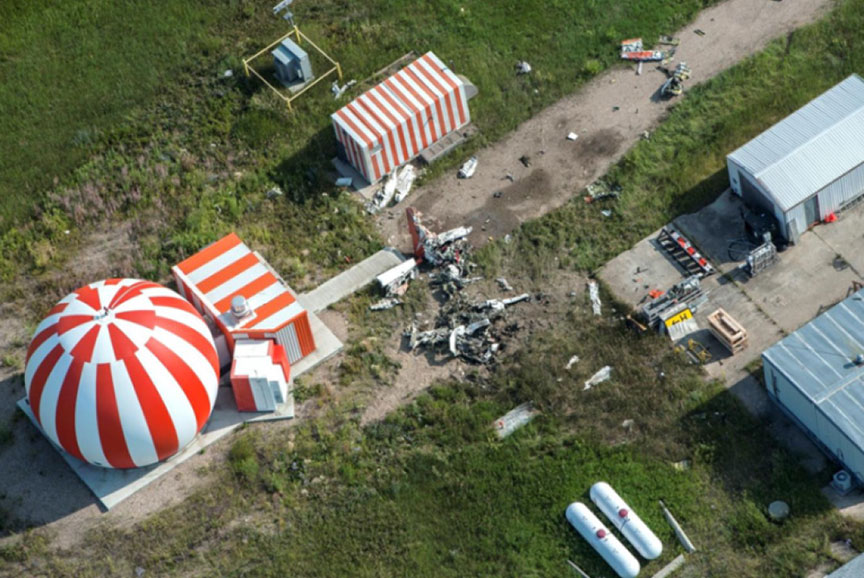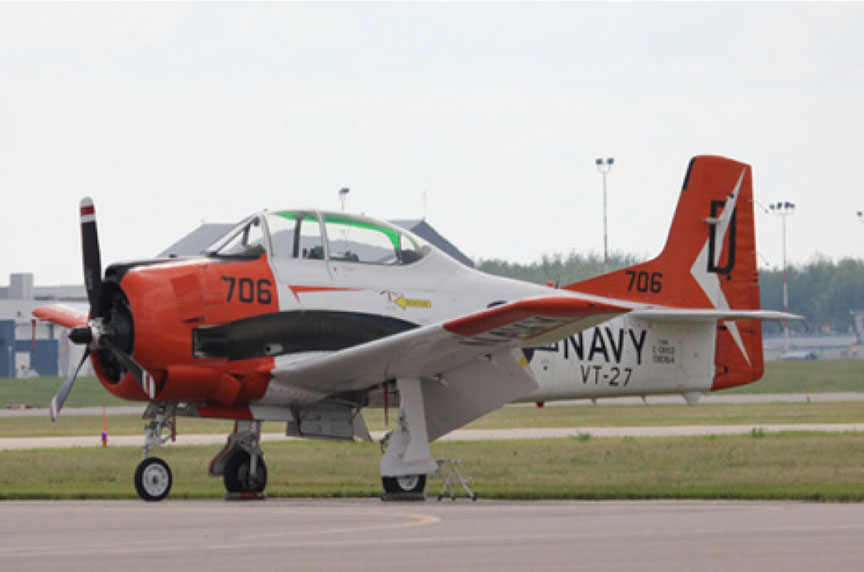Collision with terrain
North American Aviation Inc. T28-B, C-GKKD
Canadian Forces Base Cold Lake, Alberta
The Transportation Safety Board of Canada (TSB) investigated this occurrence for the purpose of advancing transportation safety. It is not the function of the Board to assign fault or determine civil or criminal liability. This report is not created for use in the context of legal, disciplinary or other proceedings. See Ownership and use of content. Masculine pronouns and position titles may be used to signify all genders to comply with the Canadian Transportation Accident Investigation and Safety Board Act (S.C. 1989, c. 3).
History of the flight
The pilot of a privately registered North American Aviation Inc. T28-B aircraft (registration C-GKKD, serial number 138362) had been engaged to provide an aerobatic demonstration for the 2016 Cold Lake Air Show at Canadian Forces Base (CFB) Cold Lake (CYOD), Alberta, on 16 and 17 July 2016. He had arrived on July 14 to participate in the practice day, scheduled for July 15.
On July 16, the first day of the air show, the pilot performed the aerobatic routine without incident.
On July 17, the pilot arrived at the airfield at 0830Footnote 1 to participate in the pre-show briefing and prepare for the routine.
Text box 1. The aerobatic routine,
as submitted to the air show operator,
for demonstration by C-GKKD
- High speed entry – show left
- Vertical loop
- Non-aerobatic wing-over reversal
- Four-point roll
- Non-aerobatic wing-over reversal
- Barrel roll
- Non-aerobatic wing-over reversal
- Slow roll
- Half-Cuban eight reversal
- Non-aerobatic lazy eight
- Non-aerobatic wing-over reversal
- Vertical loop
- Climbing aileron roll
- Climbing left turn to exit aerobatic box
- Topside canopy photo pass
At 1325, C-GKKD's engine was started and the aircraft taxied to the holding area for the take-off sequence.
At 1340, C-GKKD took off, and, at 1345, the 12-minute aerobatic demonstration began. Several still images and videos were captured throughout the demonstration.
The first half of the demonstration consisted mainly of aerobatic manoeuvres performed as listed in a submission to the air show operator (Text box 1). However, rather than a slow roll (item 8), the pilot flew what appeared to be half of a lazy eight followed by a half reverse Cuban, which was performed at show rightFootnote 2 to accomplish the reversal. It is not unusual for an aerobatic performer to modify the order of manoeuvres in a routine to compensate for conditions or for positioning. Such alterations are acceptable provided that they are consistent with the manoeuvres in the planned routine.
The pilot flew from show right to left at about 500 feet above ground level (AGL) within the defined airspace for the routine, then entered a roll just before show centre. As the aircraft reached the inverted position, the roll stopped and the nose began to pitch toward the ground. The aircraft elevator was seen to move to full up deflection as the aircraft continued toward the ground in an arc until its collision with terrain, in a near-vertical position with a slight right roll (Figure 1).
The pilot was fatally injured. No air show personnel or spectactors were injured.
Wreckage and impact information
The aircraft struck the ground at a high velocity, in a near-vertical attitude. It was destroyed by impact forces. The impact site was located among several structures used for provision of airfield services. These included the buildings that housed the precision approach radar equipment and its backup power generator, and twin 1000-gallon propane tanks (Figure 2).
Debris from the aircraft penetrated the walls of the backup power generator building; however, there was no significant damage to any of the infrastructure and it remained operational.
All major components of the aircraft were accounted for at the accident site. Based on the examination of the wreckage, and on the information from the photographs and videos collected, it was determined that the engine and flight controls had been operating normally prior to impact.
There was no post-impact fire.
Emergency response
As per the air show emergency response plan, airport rescue firefighting services responded, arriving at the site 1 minute and 34 seconds after the impact. Announcements were made to spectators, directing them to remain calm and stay where they were. The air show was immediately suspended during the emergency response, and the remainder of the show was eventually cancelled.
Aircraft information
C-GKKD was a North American Aviation Inc. tandem-seat, low-wing, all-aluminum T-28B aircraft equipped with retractable tricycle landing gear (Figure 3). It was manufactured in 1954 and was originally used as a training aircraft by the United States Navy.
The T-28B was designed for approved basic aerobatics required in the training of naval aviators, including inverted flight not to exceed 10 seconds, loops, Immelmann turns, aileron rolls, wing-overs, chandelles, upright spins, barrel rolls, and half Cuban eights.
The pilot involved in the accident had first flown the aircraft in November 2007, when it was registered as N4689P. He then trained on it, purchased it, and arranged to import it into Canada.
On 16 January 2008, N4689P entered Canada.
On 13 May 2008, an import inspection was completed.
On 28 May 2008, Transport Canada (TC) issued a special certificate of airworthiness limitedFootnote 3 for C-GKKD.
C-GKKD was powered by a Curtiss-Wright R-1820-86B radial engine. Its last engine overhaul had been performed on 27 February 2012. At the time of the accident, the engine had accumulated approximately 210 hours since the overhaul, and the aircraft's total time since new was approximately 15 740 hours. An annual inspection was completed on 09 April 2016. No outstanding defects were noted in the maintenance or aircraft logbooks, and the aircraft had been operated within its weight-and-balance and design limits.
Weather
The Cold Lake hourly weather observation recorded at 1400 (9 minutes after the accident) reported winds from the northwest at 5 knots, visibility greater than 15 statute miles, a few clouds at 6000 feet and 25 000 feet AGL, and a temperature of 22 °C. Weather conditions were not considered a factor in the accident.
Pilot
The pilot earned a private pilot licence on 21 December 1993, a commercial pilot licence on 07 October 1995, and an airline transport pilot licence on 16 January 2015. At the time of the accident, he possessed a current Group 1 instrument rating and a Class 1 medical certificate that was valid until 01 August 2016. He had accumulated 4043.2 flying hours, 461.5 of which were on the T28-B. He had flown 7.8 hours in the 90 days before the accident, and 34.4 hours in the previous 12 months.
On 09 October 2014, the pilot received a special flight operations certificate (SFOC) from TC, valid until 09 October 2016, to conduct aerobatics below 2000 feet AGL. The certificate allows the practice of low-level aerobatics over unpopulated areas with the permission of the respective land owners of those areas. On 15 June 2015, a statement of aerobatic competency, level 3 (500 feet), valid until 31 December 2016, was issued to the pilot, permitting him to perform aerobatics at an approved air show to a minimum altitude of 500 feet AGL.
During the 2015 season, the pilot performed in the following air shows without incident:
- 18–19 July 2015, Springbank, Alberta
- 28−29 July 2015, Fort St. John, British Columbia
- 14−15 August 2015, Comox, British Columbia
- 21−23 August 2015, Edmonton, Alberta
The Cold Lake Air Show was the first air show of the 2016 season in which the pilot performed. He had practised for the aerobatic routine on 2 dates prior to the air show: 02 April 2016, for 0.9 hours, and 15 May 2016, for 1.5 hours.
Air show management and oversight
Air shows in Canada must undergo an extensive approval process with TC. The requirements for an SFOC are detailed in Canadian Aviation Regulations (CARs) Subpart 603 and CARs Standard 623.
An air show operator must submit a comprehensive plan detailing how the air show will be operated and how it will meet all of the airspace restrictions that ensure the safety of the viewing crowd and the general public. The submission must include an emergency response plan and a layout of the show boxFootnote 4 and show lines (Figure 4). No routine may direct energy toward the crowd.
The show lines run parallel to the edge of the crowd at specific distances. Each performer must submit a planned routine to the air show operator, along with their proof of qualifications, licences, and insurance that are applicable to the type of aircraft and routine to be performed. Each of these items is reviewed and verified by TC before the SFOC is issued.
A TC inspector is then in attendance for at least 1 air show day to monitor the event and ensure compliance with the approved plans.
An SFOC was issued to the Commander of 4 Wing Cold Lake on 06 July 2016 and was valid until 1730 on 17 July 2016. The pilot of the T28-B was authorized by TC and the air show operator to perform the submitted routine no lower than 500 feet AGL on the 1000-foot show line. A TC inspector was present for the practice day on 15 July and on the 1st show day, 16 July. The inspector was not in attendance on the day of the accident.
This concludes the TSB's limited-scope investigation into this occurrence. The Board authorized the release of this brief on . It was officially released on .



